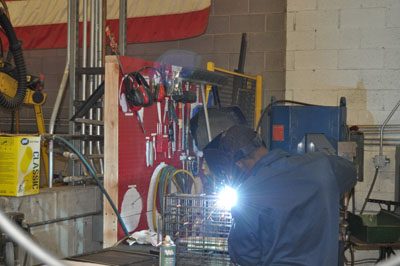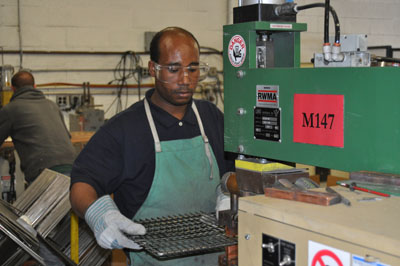ONLINE EXCLUSIVE: Marlin Steel Wire: Boosting Competitive Advantage
Three key drivers continue to propel sales and profit growth at Marlin Steel Wire Products, said Drew Greenblatt, president of the Baltimore-based company.
“First, our engineering capabilities are strong. We have two full-time designers,” Greenblatt said. “Thirty percent of our employee composition is engineers or designers. This is very heavily weighted to improve our engineering services that save clients money by improving their throughput and reducing their scrap.”
 |
| Jerry McDowell mig welding a basket for a pharmaceutical plant in Europe. |
Marlin manufactures custom wire baskets, mesh baskets, and stainless steel products. The 30-employee non-union company also provides custom wire forming and precision sheet metal fabrication for aerospace, automotive, industrial, medical, military, and pharmaceutical clients.
Greenblatt identifies the company’s procedures as the second success factor. “Our quality manual is over 200 pages, and our people are trained in quality procedures,” he said. “Our robots, such as our sheet metal forming machine, operate within +/-0.1 mm tolerance.”
Finally, he points to the company’s ability to be fast when necessary. “On a recent seven-day rush job for Northrop Grumman, for example, we shipped in five days,” Greenblatt said.
“We are united in creating and sustaining strategies for competitive advantage,” he said. “We have two full-time mechanical engineers who spend all of their time developing improved systems – ways to help streamline our systems – by going through the factory step-by-step and seeking more efficient processes.”
Improvements are not limited to the shop floor. “We’ve hired new people, such as a Wharton MBA, to help us improve our office flow,” Greenblatt said.
These change initiatives will help Marlin top $5 million in sales this year, compared to $3.8 million in 2010. Greenblatt projects sales at $7 million in 2012. “We’re very bullish,” he said. “We are expanding our manufacturing space 75 percent. We will add multiple offices for applications engineers; we’re aggressively growing.
Besides adding key personnel, Greenblatt said the company purchased two significant pieces of technology to help with the aggressive growth. The first is a top-of-the-line press brake, with a tight tolerance (plus or minus 10 microns) to improve quality.
“Our cycle will improve by a factor of 10 times, and we will set up in less than five minutes vs. one hour,” he said. “In addition, we can do 200 parts per stroke. Our engineers can do setups on the factory floor in four minutes, compared to the previous 45 minutes. Our initial quality will improve, so we will not need to throw away the first few parts after a setup.”
The second technology addition is a computer numerically controlled (CNC) machining center. “In the past, it could take one to three weeks to get a quote on parts and another three to seven weeks to ship, but our customer may want three-day delivery,” Greenblatt said. “So we can get better control on our ship dates for creative and rapid production.”
The company plans to make a $5 million investment in new robots over the next five years. “We’ve had four years of record revenue and profit despite the recession, with our first quarter 68 percent above first quarter in 2010,” he said. “Our arteries are clogged; we need to flow better.”
Getting Skin in the Game
 |
| Shishay Gebremariam welding a basket for an automotive plant in Canada. |
Pointing to industry benchmarks, Greenblatt said Marlin employees are twice as productive as competitors’ employees. “We have fabulous people. We have ‘entrepreneurs’ here who have skin in the game. With our incentive programs, each cell in the factory is paid a certain number of dollars for shipping a certain amount of product every two weeks. They can more than double their salary with the incentive program.”
A skills matrix posted in the lunchroom shows the skill levels attained by all production employees. Each skill is rated with one to four points. “It’s transparent and straightforward,” said Greenblatt. “It goes back to the meritocracy of our society. People earn more if they learn more machines.”
As chairman the Regional Manufacturing Institute, Greenblatt collaborates with other organizations to hone lean and other improvement tools. “We also bring in lean consultants,” he said. “We recently brought in Dr. Eliyahu Goldratt, co-author of The Goal and a lean manufacturing guru. He has visionary concepts about the theory of constraints. We’ve worked hard on a team brainstorming approach with our mechanical engineers so ideas can really fly. We are working very hard to get dialog so the guys on factory floor have a tremendous amount of input in making sure changes are done right.
Competitiveness
“American manufacturing is poised for a big comeback,” Greenblatt said. “We’re the No. 1 manufacturer in terms of dollars. I believe the future is going to be better as people come up with better new product ideas, and we come up with better ideas for manufacturing them.”
Total cost needs more attention in sourcing decisions, according to Greenblatt. “A lot of things are often overlooked in sourcing overseas,” he said. “People in purchasing are compensated on the basis of what is cheaper on a quote. However, it does not take into account the whole picture. Total cost includes sending someone over to China to figure out if the company is getting a high-quality product, verifying the quality of the material, and other costs. Labor costs are rising in countries such as China, and they have labor shortages. Freight delays are a consideration. It can take four to eight weeks on a boat to get products over here, and freight costs are rising. There are concerns about massive inflation in China, language barriers, different time zones and language barriers, etc. This is part of the reason we are doing well. We speak English, our quality is good, and we ship on time. As more opportunities come our way, we will hire more mechanical engineers and invest in more new technology.”


